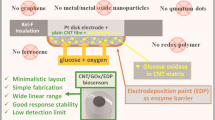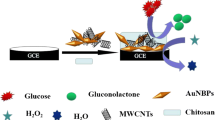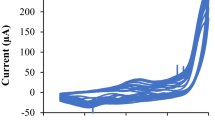Abstract
We describe the preparation and characterization of a glassy carbon electrode modified with a bionanocomposite consisting of a hyaluronic acid, dispersed carbon nanotubes, and electrostatically bound toluidine blue. The electrode was used to detect NADH in the batch and flow-injection mode of operation. The electrode was further modified by immobilizing sorbitol dehydrogenase to result in biosensor for D-sorbitol that displays good operational stability, a sensitivity of 10.6 μA mM−1 cm−2, a response time of 16 s, and detection limit in the low micromolar range. The biosensor was successfully applied to off-line monitoring of D-sorbitol during its bioconversion into L-sorbose (a precursor in the synthesis of vitamin C) by Gluconobacter oxydans. The sample assay precision is 2.5% (an average RSD) and the throughput is 65 h−1 if operated in the flow-injection mode. The validation of this biosensor against a reference HPLC method resulted in a slope of correlation of 1.021 ± 0.001 (R 2 = 0.99997).

Immobilisation of D-sorbitol dehydrogenase between two biopolymers on carbon nanotube layer provides stable and robust D-sorbitol biosensing with a mediator being electrostatically bound within the matrix. The biosensor was succesfully applied in analysis of fermentation samples with througput of assays of 65 h−1 in flow system.







Similar content being viewed by others
References
Iijima S (1991) Helical microtubules of graphitic carbon. Nature 354:56–58
Wiles PG, Abrahamson J (1978) Carbon fibre layers on arc electrodes—I: their properties and cool-down behaviour. Carbon 16:341–349
Merkoci A (2006) Carbon nanotubes in analytical sciences. Microchim Acta 152:157–174
Katz E, Willner I (2004) Biomolecule-functionalized carbon nanotubes: applications in nanobioelectronics. Chemphyschem 5:1085–1104
Vashist SK, Zheng D, Al-Rubeaan K, Luong JHT, Sheu F-S (2011) Advances in carbon nanotube based electrochemical sensors for bioanalytical applications. Biotechnol Adv 29:169–188
Banks CE, Compton RG (2005) Exploring the electrocatalytic sites of carbon nanotubes for NADH detection: an edge plane pyrolytic graphite electrode study. Analyst 130:1232–1239
Britto PJ, Santhanam KSV, Ajayan PM (1996) Carbon nanotube electrode for oxidation of dopamine. Bioelectrochem Bioenerg 41:121–125
Musameh M, Wang J, Merkoci A, Lin YH (2002) Low-potential stable NADH detection at carbon-nanotube-modified glassy carbon electrodes. Electrochem Commun 4:743–746
Wang J, Musameh M, Lin YH (2003) Solubilization of carbon nanotubes by Nafion toward the preparation of amperometric biosensors. J Am Chem Soc 125:2408–2409
Kachoosangi RT, Musameh MM, Abu-Yousef I, Yousef JM, Kanan SM, Xiao L, Davies SG, Russell A, Compton RG (2009) Carbon nanotube−ionic liquid composite sensors and biosensors. Anal Chem 81:435–442
Kumar SA, Chen SM (2008) Electroanalysis of NADH using conducting and redox active polymer/carbon nanotubes modified electrodes-a review. Sensors 8:739–766
Gorton L, Domínguez E (2002) Electrocatalytic oxidation of NAD(P)H at mediator-modified electrodes. Rev Mol Biotechnol 82:371–392
Radoi A, Compagnone S (2009) Recent advances in NADH electrochemical sensing design. Bioelectrochemistry 76:126–134
Katakis I, Dominguez E (1997) Catalytic electrooxidation of NADH for dehydrogenase amperometric biosensors. Microchim Acta 126:11–32
Arakawa T, Koshida T, Gessei T, Miyajima K, Takahashi D, Kudo H, Yano K, Mitsubayashi K (2011) Biosensor for L-phenylalanine based on the optical detection of NADH using a UV light emitting diode. Microchim Acta 173:199–205
Korpan YI, Soldatkin OO, Sosovska OF, Klepach HM, Csoregi E, Vocanson F, Jaffrezic-Renault N, Gonchar MV (2010) Formaldehyde-sensitive conductometric sesnors based on commercial and recombinant formaldehyde dehydrogenase. Microchim Acta 170:337–344
Valcárcel M, Cárdenas S, Simonet BM (2007) Role of carbon nanotubes in analytical science. Anal Chem 79:4788–4797
Dias AMGC, Hussain A, Marcos AS, Roque ACA (2011) A biotechnological perspective on the application of iron oxide magnetic colloids modified with polysaccharides. Biotechnol Adv 29:142–155
Krajewska B (2004) Application of chitin- and chitosan-based materials for enzyme immobilizations: a review. Enzyme Microb Technol 35:126–139
Bhattacharyya S, Guillott S, Dabboue H, Tranchant JF, Salvetat JP (2008) Carbon nanotubes as structural nanofibers for hyaluronic acid hydrogel scaffolds. Biomacromolecules 9:505–509
Rinaudo M (2006) Chitin and chitosan: properties and applications. Prog Polym Sci 31:603–632
Koev ST, Dykstra PH, Luo X, Rubloff GW, Bentley WE, Payne GF, Ghodssi R (2010) Chitosan: an integrative biomaterial for lab-on-a-chip devices. Lab Chip 10:3026–3042
Tkac J, Ruzgas T (2006) Dispersion of single walled carbon nanotubes. Comparison of different dispersing strategies for preparation of modified electrodes toward hydrogen peroxide detection. Electrochem Commun 8:899–903
Zhang MG, Smith A, Gorski W (2004) Carbon nanotube−chitosan system for electrochemical sensing based on dehydrogenase enzymes. Anal Chem 76:5045–5050
Tkac J, Whittaker JW, Ruzgas T (2007) The use of single walled carbon nanotubes dispersed in a chitosan matrix for preparation of a galactose biosensor. Biosens Bioelectron 22:1820–1824
Rappathy D, Gopalan AY, Lee KP (2009) Synergistic contributions of multiwall carbon nanotubes and gold nanoparticles in a chitosan–ionic liquid matrix towards improved performance for a glucose sensor. Electrochem Commun 11:397–401
Razal JM, Gilmore KJ, Wallace GG (2008) Carbon nanotube biofiber formation in a polymer-free coagulation bath. Adv Funct Mater 18:61–66
Kogan G, Soltes L, Stern R, Gemeiner P (2007) Hyaluronic acid: a natural biopolymer with a broad range of biomedical and industrial applications. Biotechnol Lett 29:17–25
Moulton SE, Maugey M, Poulin P, Wallace GG (2007) Liquid crystal behavior of single-walled carbon nanotubes dispersed in biological hyaluronic acid solutions. J Am Chem Soc 129:9452–9457
Filip J, Šefčovičová J, Tomčík P, Gemeiner P, Tkac J (2011) A hyaluronic acid dispersed carbon nanotube electrode used for a mediatorless NADH sensing and biosensing. Talanta 84:355–361
Svitel J, Tkac J, Vostiar I, Navratil M, Stefuca V, Bucko M, Gemeiner P (2006) Gluconobacter in biosensors: applications of whole cells and enzymes isolated from Gluconobacter and Acetobacter to biosensor construction. Biotechnol Lett 28:2003–2010
De Muynck C, Pereira CSS, Naessens M, Parmentier S, Soetaert W, Vandamme EJ (2007) The genus Gluconobacter oxydans: comprehensive overview of biochemistry and biotechnological applications. Crit Rev Biotechnol 27:147–171
Gilli R, Kacurakova M, Mathlouthi M, Navarini L, Paoletti S (1994) FTIR studies of sodium hyaluronate and its oligomers in the amorphous solid phase and in aqueous solution. Carbohydr Res 263:315–326
Lawrence NS, Wang J (2006) Chemical adsorption of phenothiazine dyes onto carbon nanotubes: toward the low potential detection of NADH. Electrochem Commun 8:71–76
Ranganathan S, Guo R, Murray RW (2007) Nanoparticle films as electrodes:voltammetric sensitivity to the nanoparticle energy gap. Langmuir 23:7372–7377
Radoi A, Compagnone D, Batic M, Klincar J, Gorton L, Palleschi G (2007) NADH screen-printed electrodes modified with zirconium phosphate, Meldola blue, and Reinecke salt. Application to the detection of glycerol by FIA. Anal Bioanal Chem 387:1049–1058
Fanjul-Bolado P, Queipo P, Lamas-Ardisana PJ, Costa-Garcia A (2007) Manufacture and evaluation of carbon nanotube modified screen-printed electrodes as electrochemical tools. Talanta 74:427–433
Munteanu FD, Mano N, Kuhn A, Gorton L (2004) NADH electrooxidation using carbon paste electrodes modified with nitro-fluorenone derivatives immobilized on zirconium phosphate. J Electroanal Chem 564:167–178
Stergiou DV, Prodromidis MI, Veltsistas PG, Evmiridis NP (2004) Study of the electrochemical behavior of disperse blue 1-modified graphite electrodes. Application to the flow determination of NADH. Electroanalytical 16:949–954
Sha YF, Gao Q, Qi B, Yang XR (2004) Electropolymerization of azure B on a screen-printed carbon electrode and its application to the determination of NADH in a flow injection analysis system. Microchim Acta 148:335–341
Wang Y, You CP, Zhang S, Kong JL, Marty JL, Zhao DY, Liu BH (2009) Electrocatalytic oxidation of NADH at mesoporous carbon modified electrodes. Microchim Acta 167:75–79
Lin WJ, Liao CS, Jhang JH, Tsai YC (2009) Graphene modified basal and edge plane pyrolytic graphite electrodes for electrocatalytic oxidation of hydrogen peroxide and β-nicotinamide adenine dinucleotide. Electrochem Commun 11:2153–2156
Tsai YC, Huang JD, Chiu C-C (2007) Amperometric ethanol biosensor based on poly(vinyl alcohol)–multiwalled carbon nanotube–alcohol dehydrogenase biocomposite. Biosens Bioelectron 22:3051–3056
Wooten M, Gorski W (2010) Facilitation of NADH electro-oxidation at treated carbon nanotubes. Anal Chem 82:1299–1304
Tsai YC, Chen SY, Liaw HW (2007) Immobilization of lactate dehydrogenase within multiwalled carbon nanotube-chitosan nanocomposite for application to lactate biosensors. Sens Actuat B: Chem 125:474–481
Zhai XR, Wei WZ, Zeng JX, Gong SG, Yin J (2006) Layer-by-layer film based on chitosan/carbon nanotubes, and its application to electrocatalytic oxidation of NADH. Microchim Acta 154:315–320
Sefcovicova J, Vikartovska A, Patoprsty V, Magdolen P, Katrlik J, Tkac J, Gemeiner P (2009) Off-line FIA monitoring of D-sorbitol consumption during L-sorbose production using a sorbitol biosensor. Anal Chim Acta 644:68–71
Saidman SB, Lobo-Castanon MJ, Miranda-Ordieres AJ, Tunon-Blanco P (2000) Amperometric detection of D-sorbitol with NAD+−D -sorbitol dehydrogenase modified carbon paste electrode. Anal Chim Acta 424:45–50
Hassler BL, Kohli N, Zeikus JG, Lee I, Worden RM (2007) Renewable dehydrogenase-based interfaces for bioelectronic applications. Langmuir 23:7127–7133
Hassler BL, Amundsen TJ, Zeikus JG, Lee I, Worden RM (2008) Versatile bioelectronic interfaces on flexible non-conductive substrates. Biosens Bioelectron 23:1481–1487
El-Kabbani O, Darmanin C, Chung RP (2004) Sorbitol dehydrogenase: structure, function and ligand design. Curr Med Chem 11:465–476
Ruzicka J, Hansen EH (2008) Retro-review of flow-injection analysis. Trends Anal Chem 27:390–393
Bilitewski U (2005) Biosensors for bioprocess monitoring. Compr Anal Chem 44:539–578
Wu Q, Maskus M, Pariente F, Tobalina F, Fernandez VM, Lorenzo E, Abruna HD (1996) Electrocatalytic oxidation of NADH at glassy carbon electrodes modified with transition metal complexes containing 1,10-phenanthroline-5,6-dione ligands. Anal Chem 68:3688–3696
Du P, Liu SN, Wu P, Cai CX (2007) Single-walled carbon nanotubes functionalized with poly(nile blue A) and their application to dehydrogenase-based biosensors. Electrochim Acta 53:1811–1823
Liu SN, Cai CX (2007) Immobilization and characterization of alcohol dehydrogenase on single-walled carbon nanotubes and its application in sensing ethanol. J Electroanal Chem 602:103–114
Zheng HT, Zhou JL, Zhang JM, Huang R, Jia HL, Suye S (2009) Electrical communication between electrode and dehydrogenase by a ferrocene-labeled high molecular-weight cofactor derivative: application to a reagentless biosensor. Microchim Acta 165:109–115
Gessei T, Sato H, Kazawa E, Kudo H, Saito H, Mitsubayashi K (2009) Bio-sniffers for ethanol and acetaldehyde using carbon and Ag/AgCl coated electrodes. Microchim Acta 165:179–186
Zhou HJ, Zhang ZP, Yu P, Su L, Ohsaka T, Mao LQ (2010) Noncovalent attachment of NAD(+) cofactor onto carbon nanotubes for preparation of integrated dehydrogenase-based electrochemical biosensors. Langmuir 26:6028–6032
Chakraborty S, Raj CR (2007) Amperometric biosensing of glutamate using carbon nanotube based electrode. Electrochem Commun 9:1323–1330
Campbell CE, Rishpon J (2001) NADH oxidation at the honey-comb like structure of active carbon: coupled to formaldehyde and sorbitol dehydrogenases. Electroanal 13:17–20
Acknowledgements
The financial supports from projects VEGA 1/0066/09 and 1/0335/10; COST CM8T D43 and SAV-FM-EHP-2008-04-04 are acknowledged. This contribution/publication is the result of the project implementation: Centre for materials, layers and systems for applications and chemical processes under extreme conditions supported by the Research & Development Operational Program funded by the ERDF.
Author information
Authors and Affiliations
Corresponding author
Electronic supplementary material
Below is the link to the electronic supplementary material.
ESM 1
(DOC 523 kb)
Rights and permissions
About this article
Cite this article
Šefčovičová, J., Filip, J., Tomčík, P. et al. A biopolymer-based carbon nanotube interface integrated with a redox shuttle and a D-sorbitol dehydrogenase for robust monitoring of D-sorbitol. Microchim Acta 175, 21–30 (2011). https://doi.org/10.1007/s00604-011-0641-0
Received:
Accepted:
Published:
Issue Date:
DOI: https://doi.org/10.1007/s00604-011-0641-0




